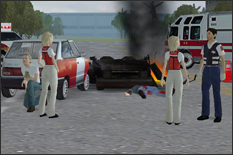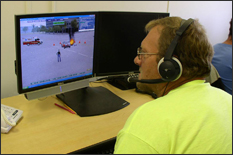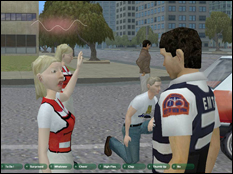Preparing for Real-Life Disasters in the Virtual World |
|
FOR IMMEDIATE RELEASE CONTACT: Missy Corley Michael L. Pack
The game, developed by researchers at the A. James Clark School of Engineering, is sponsored by the I-95 Corridor Coalition. Participants interact over the web in an unlimited number of emergency situations, from car accidents, to chemical spills, to mass casualty scenarios. Such "serious" games focus on developing management and leadership skills.
"This project provides incident responders from all disciplines the opportunity to train together in real time for the purpose of learning the latest best practices in incident scene safety, coordination and quick clearance of highway events," de Vries said.
The players experience the scenarios real-time and can see how their actions and the actions of others affect the situation, for good or bad. Sessions are recorded so training staff and participants can review and critique what happened. "Every scenario has a moderator watching who can pause and resume the game to give feedback," said Michael Pack, laboratory director of the Clark School’s Center for Advanced Transportation Technology Laboratory (CATT Lab) at the University of Maryland. "He or she can also throw in ‘hiccups’ to test the reactions of the players." For example, in a scenario involving a 3-car accident, the moderator can quickly and easily add a tractor trailer spilling fuel to the mix or cause a fire to increase in intensity. "There’s never the same thing twice," said Pack. A steering committee made up of police officers, firefighters, EMTs and federal and state transportation officials is developing training criteria for the game, which the Coalition hopes to use to certify emergency responders. The Coalition devoted $1.4 million for the game’s development and plans to provide more funding for its implementation. "This training tool is specifically targeted to promote the safety of the responders themselves, as well as the traveling public who encounter highway incidents," de Vries said. "We are targeting core competencies that have been developed through careful study and coordination with the National Traffic Incident Management Coalition's National Unified Goal for Incident Responders, the Federal Highway Administration International Scan report for Incident Response, and the I-95 Corridor Coalition's Quick Clearance Program." Emergency responders in New Jersey and Georgia will begin testing the system early in 2008 and it may be deployed up and down I-95 later that year. Forterra Inc. designed the game engine, including capabilities for voice communications and 3-D interaction over the Web. The same platform is used by the military to train soldiers and is the basis of MTV’s "Virtual Laguna Beach." CATT Lab researchers, including undergraduate students from aerospace and mechanical engineering, computer science and art disciplines, worked with the Coalition to design the game’s scenarios, and are reprogramming the game engine to customize it to the Coalition's specifications. More Information About the A. James Clark School of Engineering Visit the Clark School homepage at www.eng.umd.edu. ###
|
|
||||||||||||








